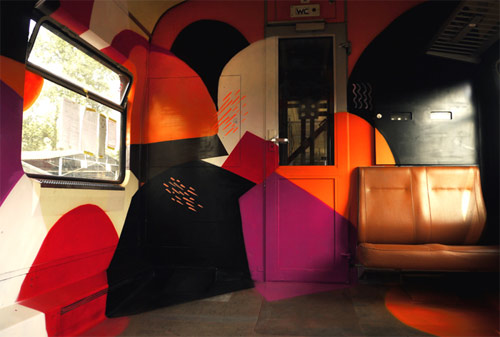Tired of images being perfect and sleek, the two photographers decided to see what happens when fashion pictures are destroyed, manipulated or scratched
Text by Felicity Shaw from Dazed & Confused
The discussion behind the concept of ‘perfection’ and the ‘perfect’ imagined self has been explored extensively throughout both psychological theory and creative practice, addressing media and advertisement constructs as to what is deemed as aesthetically perfect. This hyper-reality of mannequin-like idealism is explored further in this month’s exhibition at Camer16 in Milan, 'Destroyed Perfection'. We caught up with Anthony Maule and Sandy Kim who are showcasing their work to find out more about how these barriers can be broken down…
Dazed Digital: Your previous work contains hyper perfect fashion images – what made you break away from this?
Anthony Maule: It was an emotional response. One day I just wanted to destroy everything I’d been working on to see what would happen, I guess it was a moment of madness, so impulsively I did and it kind of went from there. I started destroying other people’s work, advertising campaigns, complete magazines, clothing, etc. Whatever was around me really; there’s a lot of appropriated art in the show.
DD: Why do you think advertisers and fashion magazines continue to use unrealistic, mannequin like models for their campaigns?
Anthony Maule: I think for a lot of them it probably has a lot to do with respecting a tradition and that tradition being the safest playing ground for them to be working on right now. I think the advertisers are in the most difficult position because they’re directly in the firing line of public opinion. They have the history and integrity of the brand and the fashion industry to consider at the same time as being aware of sales and public criticism so it’s a difficult balance to get right.
DD: Do you think perfection is an impossible concept?
Anthony Maule: Perfection is obviously connected to taste so what’s perfect for one person isn’t necessarily going to be perfect for someone else, if perfection is about you wanting to achieve your personal goals then no I don’t think the concept is impossible. It can be a huge driving force for positive thinking, innovation and progress and can be incredibly stimulating. However, I think the desire for perfection is much more interesting than perfection itself. If everything was perfect, it would be boring, it’s such a weird paradox, if you look around, everyone is obsessed with this idea of a virtual utopia but the reality of it would be dreadful. The fact that it’s impossible is what keeps us ticking.
DD: How important is it to you to break down the barriers as to what is deemed as perfect?
Anthony Maule: From my perspective it’s very important, that’s really why I was so interested in doing this show. Perfection isn’t just about control, it’s about loosing control as well, it’s not just about action but also about reaction. It shows the frigid nature of discipline destroyed by passion and emotion so in my opinion I think the work becomes more complete, more real and closer to reality again and definitely poses some interesting questions about which is the more perfect out of the two.
DD: You interact with the images by destroying, manipulating and scratching. Could you tell us a little about this process?
Anthony Maule: Yeah, it’s Action painting, so it’s all very impulsive and in the moment. Mainly I’ve been working with spray paints, adhesives, burned ink, heat guns, blood, staples, axe wounds and surgical stitches. The processes are symbolic of a cycle. Construction – deconstruction – reconstruction, it’s taken from what we see in life. I treated the artwork as if it were flesh at times, that’s quite an interesting concept in itself.
DD: What does the exhibition title, ‘Destroyed Perfection’ mean to you?
Sandy Kim: I never saw my life as being perfect, nor do I strive for perfection in my photos. So I'm not really sure how it addresses the theme because it was never perfect to begin with. But then I think about it again and it does address the theme because my idea of perfection was destroyed while growing up.
DD: Your work seems to reference acclaimed photographers Nan Goldin and Larry Clark. Are these artists’ references for your work?
Sandy Kim: Honestly, I had never heard of Nan Goldin or Larry Clark until people started comparing my work to theirs. I grew up in Portland with a crowd of thugged-out Asian kids who had no interest in art. After becoming familiar with their work of course I'm completely obsessed.
DD: How autobiographical is your work?
Sandy Kim: You only live once - you might as well capture it.
DD: Do you have any other projects you would like to realise? If so, what?
Sandy Kim: Too many projects, not enough time.
The exhibition runs from February 24 to April 9, 2011 at Camera 16, Via Pisacane 16, 20129 Milano, Italy









































